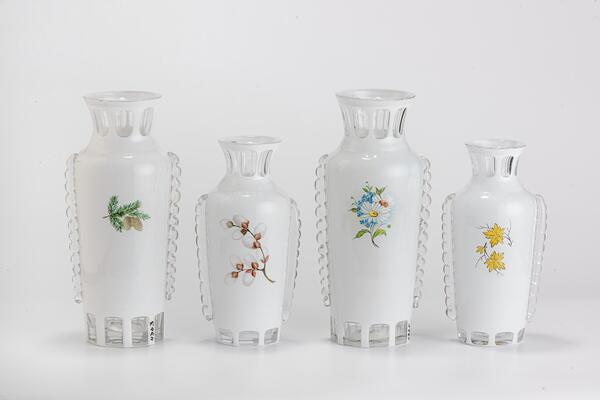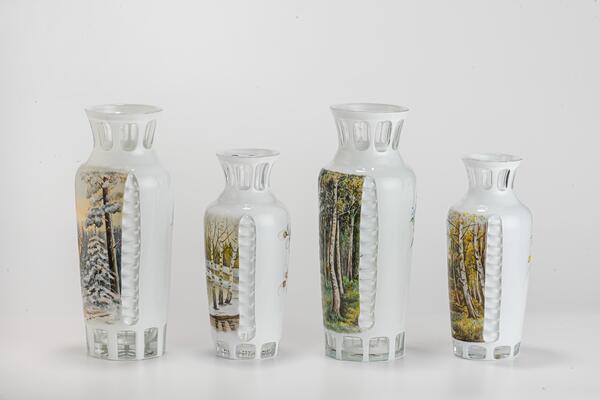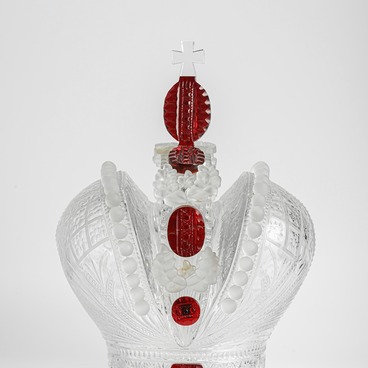The composition “Seasons” consists of four vases in the form of inverted truncated cones. The main decorative element was the milk glass overlay based on crystal. The vases “Summer” and “Winter” are slightly higher than “Autumn” and “Spring”. Each vase has a small flaring neck; the sides of the body are decorated with two undulating colorless moldings.
On the front, each vase is completely covered with painting, on the reverse side there are small drawings that complement the front image. All illustrations are made with polychrome paints and fixed on the surface by firing. In his works, the craftsman Alexander Voronchikhin preserved the gold and paint decorating technique that was used at the Nikolsko-Bakhmetevsky factory in the past centuries.
In the 18th century, the factory produced colored and colorless glassware that had simple shapes. Matte engraving, as well as painting in polychrome, gold and silver was used for decoration. Sometimes gilded glassware from the Bakhmetevsky factory is almost indistinguishable from samples of the Imperial Glass Factory, which was the leader in the industry; but the paintings of the Nikolsky masters were considered to be more original and free.
The coloristic principles of the Bakhmetevsky factory were formed more under the influence of the Russian than the European art. In the middle of the 19th century, European craftsmen gave precedence to saturated colors, bright contrasts, layering and abundant decorative elements. Russian samples were characterized by more restraint and a noble color palette.
It is this kind of painting that adorns the vases of this composition: a deer standing in a snowy meadow, snow melting in spring, a summer day in the forest, falling autumn leaves and a quiet river.
The painter Alexander Voronchikhin did not receive any professional art education. However, his observation and natural endowment, which developed under the guidance of his teacher Nikolay Alekseevich Voinov, made Alexander a remarkable artist. Since 1957, Alexander Alekseevich was engaged in glass painting in the experimental art workshop of the factory. He created both copies of museum exhibits and many original objects for mass production. Voronchikhin’s drawings arrest the viewer’s attention with bright colors and a variety of patterns.
On the front, each vase is completely covered with painting, on the reverse side there are small drawings that complement the front image. All illustrations are made with polychrome paints and fixed on the surface by firing. In his works, the craftsman Alexander Voronchikhin preserved the gold and paint decorating technique that was used at the Nikolsko-Bakhmetevsky factory in the past centuries.
In the 18th century, the factory produced colored and colorless glassware that had simple shapes. Matte engraving, as well as painting in polychrome, gold and silver was used for decoration. Sometimes gilded glassware from the Bakhmetevsky factory is almost indistinguishable from samples of the Imperial Glass Factory, which was the leader in the industry; but the paintings of the Nikolsky masters were considered to be more original and free.
The coloristic principles of the Bakhmetevsky factory were formed more under the influence of the Russian than the European art. In the middle of the 19th century, European craftsmen gave precedence to saturated colors, bright contrasts, layering and abundant decorative elements. Russian samples were characterized by more restraint and a noble color palette.
It is this kind of painting that adorns the vases of this composition: a deer standing in a snowy meadow, snow melting in spring, a summer day in the forest, falling autumn leaves and a quiet river.
The painter Alexander Voronchikhin did not receive any professional art education. However, his observation and natural endowment, which developed under the guidance of his teacher Nikolay Alekseevich Voinov, made Alexander a remarkable artist. Since 1957, Alexander Alekseevich was engaged in glass painting in the experimental art workshop of the factory. He created both copies of museum exhibits and many original objects for mass production. Voronchikhin’s drawings arrest the viewer’s attention with bright colors and a variety of patterns.







